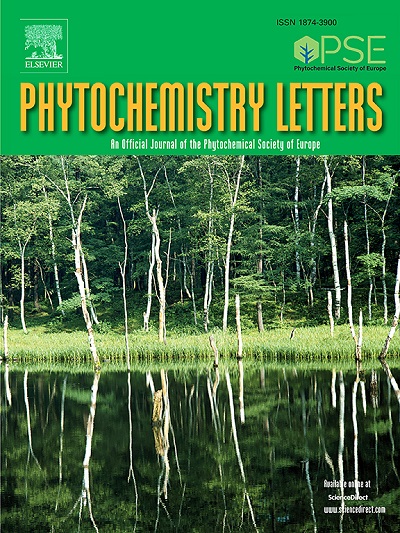Gigantolevisins A-C, tyrosinase inhibitory benzylidenes from the shoots of Gigantochloa levis(虎尾兰嫩枝中提取的具有抑制酪氨酸酶作用的苯亚甲基烯类
IF 1.3
4区 生物学
Q4 CHEMISTRY, MEDICINAL
引用次数: 0
摘要
酪氨酸酶的过度活性与黑色素的过度生成有关,可导致色素沉着、氧化应激、褐变和黑色素瘤风险的增加。由于酪氨酸酶的过度表达会产生这些不利影响,研究工作的重点是寻找能有效抑制这种酶的生物活性化合物。这项研究是利用 Gigantochloa levis(G. levis)的嫩芽寻找酪氨酸酶抑制剂,结果发现了三种以前未曾描述过的苯亚甲基衍生物(1-3)和两种已知化合物,具有很好的抗酪氨酸酶活性。根据光谱数据和 X 射线晶体学分析,新化合物被命名为 gigantolevisins A-C,两个已知化合物被命名为 (E)-3-(4-hydroxyphenyl)-2-phenylacrylaldehyde (4) 和 (E)-2,3-bis(4-hydroxyphenyl)acryaldehyde (5)。与阳性对照曲酸(IC50 值为 43 ± 3 μM)相比,分离出的化合物对酪氨酸酶有 42 % 至 58 % 的抑制作用(IC50 值为 400-286 ± 15 μM)。研究结果表明,虽然分离出的化合物的效力低于曲酸,但它们能有效抑制酪氨酸酶的活性。因此,这项研究凸显了 G. levis 嫩芽治疗黑色素相关疾病的潜力。本文章由计算机程序翻译,如有差异,请以英文原文为准。
Gigantolevisins A–C, tyrosinase inhibitory benzylidenes from the shoots of Gigantochloa levis
The excessive tyrosinase activity has been linked to the overproduction of melanin which can lead to hyperpigmentation, oxidative stress, browning, and an increased risk of melanoma. Due to these detrimental effects associated with the overexpression of tyrosinase, research efforts are focused on finding bioactive compounds that can inhibit this enzyme efficiently. This study, conducted to find tyrosinase inhibitors utilizing the shoots of Gigantochloa levis (G. levis), produced three previously undescribed benzylidene derivatives (1–3) and two known compounds, with promising anti-tyrosinase activity. The new compounds were designated as gigantolevisins A–C, and the two known compounds as (E)-3-(4-hydroxyphenyl)-2-phenylacrylaldehyde (4) and (E)-2,3-bis(4-hydroxyphenyl)acrylaldehyde (5), respectively, based on the spectroscopic data and X-ray crystallographic analysis. The isolated compounds showed inhibition effects against tyrosinase, ranging from 42 % to 58 % (IC50 values of >400–286 ± 15 μM) in comparison to the positive control Kojic acid with 100 % inhibition (IC50 value of 43 ± 3 μM). The findings suggest that, while the isolated compounds are less potent than Kojic acid, they can be effective in inhibiting tyrosinase activity. Thus, the study highlights the therapeutic potential of G. levis shoots for treating melanin-related conditions.
求助全文
通过发布文献求助,成功后即可免费获取论文全文。
去求助
来源期刊

Phytochemistry Letters
生物-生化与分子生物学
CiteScore
3.00
自引率
11.80%
发文量
190
审稿时长
34 days
期刊介绍:
Phytochemistry Letters invites rapid communications on all aspects of natural product research including:
• Structural elucidation of natural products
• Analytical evaluation of herbal medicines
• Clinical efficacy, safety and pharmacovigilance of herbal medicines
• Natural product biosynthesis
• Natural product synthesis and chemical modification
• Natural product metabolism
• Chemical ecology
• Biotechnology
• Bioassay-guided isolation
• Pharmacognosy
• Pharmacology of natural products
• Metabolomics
• Ethnobotany and traditional usage
• Genetics of natural products
Manuscripts that detail the isolation of just one new compound are not substantial enough to be sent out of review and are out of scope. Furthermore, where pharmacology has been performed on one new compound to increase the amount of novel data, the pharmacology must be substantial and/or related to the medicinal use of the producing organism.
 求助内容:
求助内容: 应助结果提醒方式:
应助结果提醒方式:


